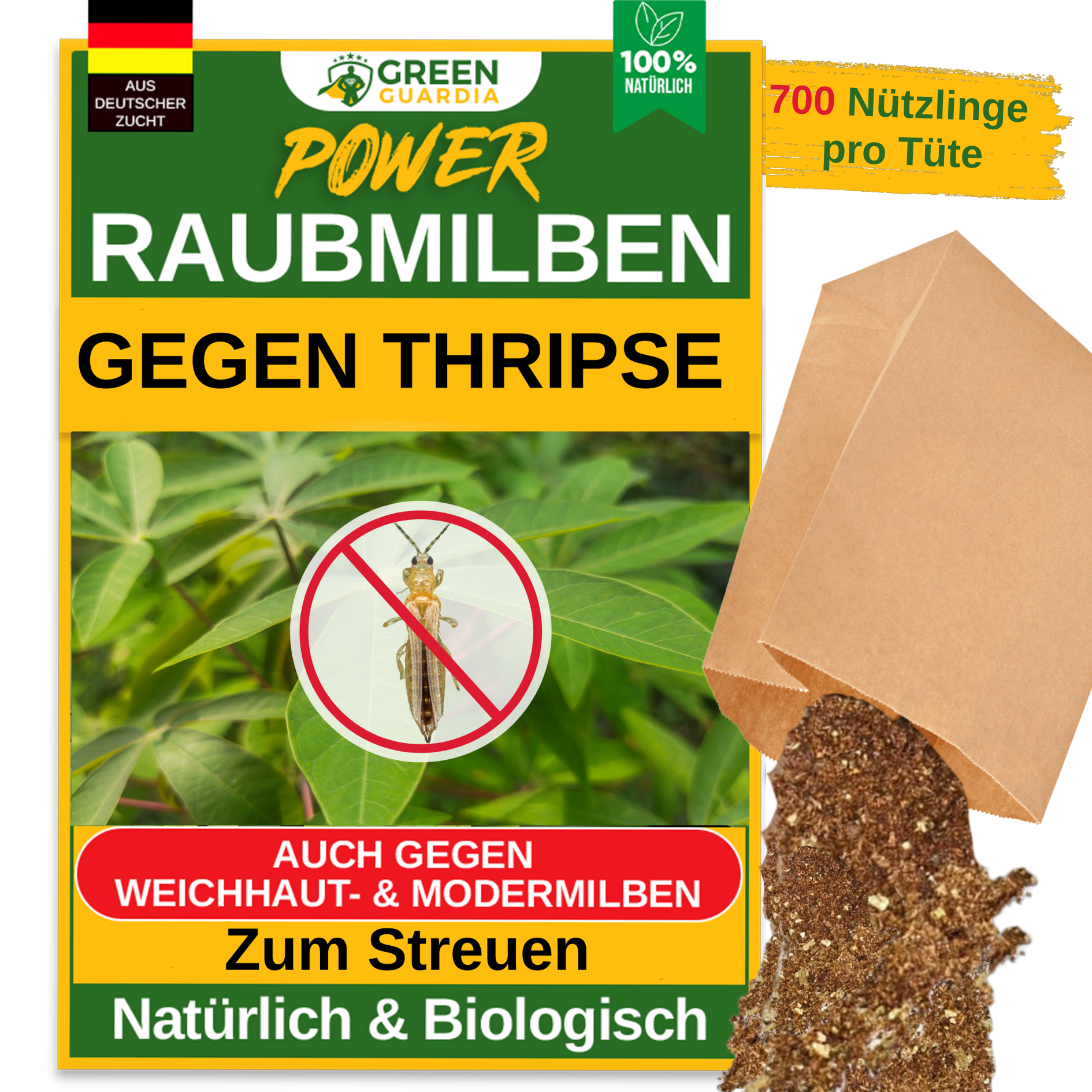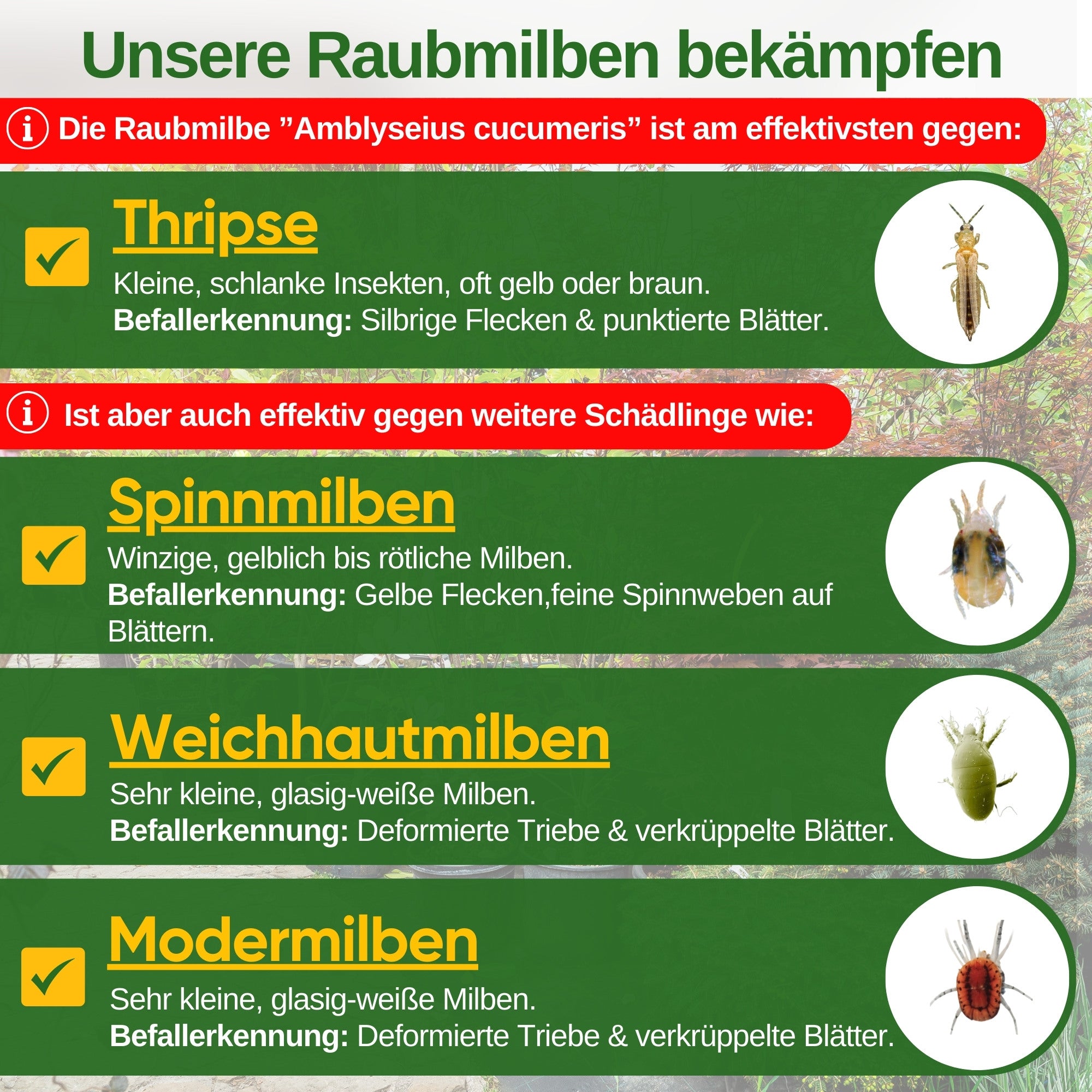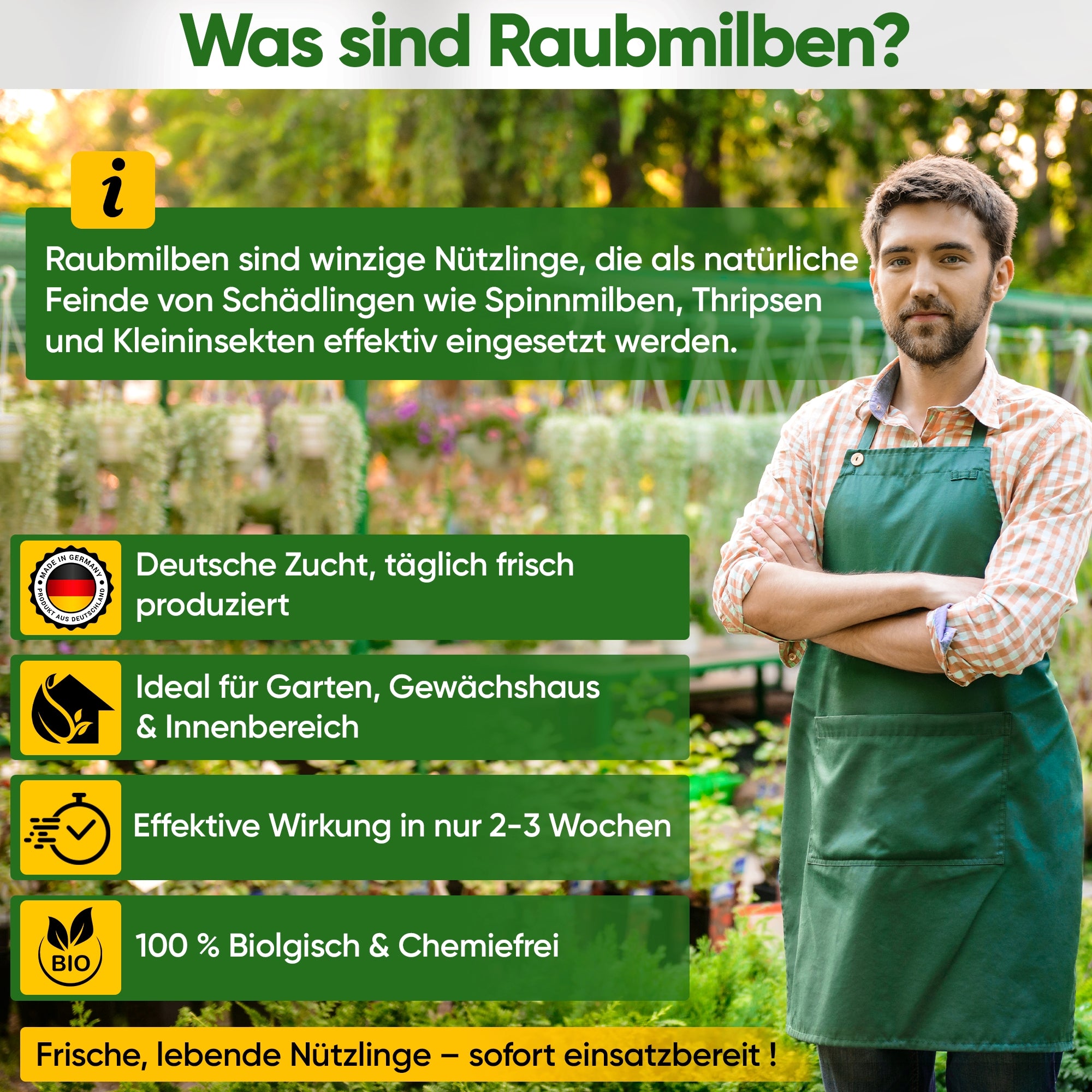
Number of bags














Predatory mites against thrips – loose product
-
100% natural help against thrips infestation
-
From German breeding – delivered quickly
-
Completely chemical-free – no residues
-
Discreet, effective & biologically sustainable
-
Safe for children and pets
Number of bags
In stock - in 2-4 working days with you
Was unsere Kund*innen sagen
-
Wirksamkeit
kaum Wirkung teilweise wirksam sehr wirksam -
Anwendung
kompliziert etwas Aufwand kinderleicht -
Lieferqualität
schlechter Zustand ok top Qualität
Choose options
-
100% natural help against thrips infestation
-
From German breeding – delivered quickly
-
Completely chemical-free – no residues
-
Discreet, effective & biologically sustainable
-
Safe for children and pets
Number of bags
In stock - in 2-4 working days with you
Was unsere Kund*innen sagen
-
Wirksamkeit
kaum Wirkung teilweise wirksam sehr wirksam -
Anwendung
kompliziert etwas Aufwand kinderleicht -
Lieferqualität
schlechter Zustand ok top Qualität
-
100% natural help against thrips infestation
-
From German breeding – delivered quickly
-
Completely chemical-free – no residues
-
Discreet, effective & biologically sustainable
-
Safe for children and pets
Number of bags
In stock - in 2-4 working days with you
Was unsere Kund*innen sagen
-
Wirksamkeit
kaum Wirkung teilweise wirksam sehr wirksam -
Anwendung
kompliziert etwas Aufwand kinderleicht -
Lieferqualität
schlechter Zustand ok top Qualität
Predatory mites against thrips – natural & reliable
GREEN GUARDIA predatory mites are tiny but extremely effective beneficial insects for biological control of thrips in the garden, greenhouse, or indoors. Whether scattered or in hanging bags , predatory mites are the perfect alternative to chemical pesticides.
These active hunters comb through leaves, flowers, and substrates in search of prey. They consume thrips larvae, eggs, and other small pests – leaving no residue or adverse effects on humans, plants, or pets.
Areas of application for predatory mites
- Indoor & ornamental plants: Effective indoors, even in limited light.
- Greenhouse & raised beds: Ideal for sustainable plant protection in closed systems.
- Vegetable & herb garden: Gentle on edible plants, safe for bees & beneficial insects.
- Indoor growing & balcony plants: Discreet, effective and without chemicals.
Application & Tips
- Application: Sprinkle directly onto infested plants or attach sachets – depending on the variant.
- Temperature: Optimal from 18 °C – predatory mites are active and develop quickly.
- Humidity: Slightly increased humidity (60–80%) improves the effect.
- No pesticides: Avoid chemicals – they can harm predatory mites.
- Storage: Apply as soon as possible upon receipt. Short-term storage at 8–12 °C for 1–2 days is possible.
🌿 Conclusion: GREEN GUARDIA predatory mites are the sustainable solution for thrips control – natural, residue-free and particularly
🌿 Raubmilben gegen Thripse – Anwendung einfach gemacht
Die GREEN GUARDIA Raubmilben sind effektive Nützlinge zur biologischen Bekämpfung von Thripsen – ganz ohne Chemie. Sie eignen sich hervorragend für den flexiblen Einsatz im Haus, Garten oder Gewächshaus.
✅ Einfache Anwendung
- Streuvariante: Tüte vorsichtig öffnen und den Inhalt direkt auf Blätter oder Erde streuen. Die Raubmilben verteilen sich eigenständig und gehen aktiv auf die Suche nach Schädlingen.
📏 Anwendungsmengen
Bei akutem Befall: 1 Tüte pro Pflanze oder ca. 10 m²
Zur Vorbeugung: 1 Tüte für bis zu 2 Pflanzen oder ca. 20 m²
📆 Anwendungstipps & Intervalle
- Beginne bei den ersten Anzeichen von Thripsbefall.
- Je nach Befall alle 1–2 Wochen wiederholen.
- Verwende Gelbtafeln zur Kontrolle des Befallsdrucks.
- Optimale Wirkung bei Temperaturen ab 18 °C und mittlerer Luftfeuchtigkeit.
⚠️ Hinweis: Bitte mindestens 6 Wochen vor und nach der Anwendung keine synthetischen Pflanzenschutzmittel verwenden – sie können die Raubmilben schädigen oder ihre Wirkung aufheben.
Was sind Thripse?
Thripse – auch Fransenflügler genannt – sind winzige, schlanke Insekten mit auffällig gefransten Flügeln. Sie zählen zu den häufigsten Pflanzenschädlingen und befallen besonders gern Zimmerpflanzen, Zierpflanzen, Obst, Gemüse und Kräuter im Haus, Garten oder Gewächshaus.
Thripse saugen Pflanzensäfte aus Blättern, Blüten oder Früchten. Dabei hinterlassen sie silbrige Flecken, kleine schwarze Kotpunkte und führen zu Verkrüppelungen oder Welkeerscheinungen. Ein starker Befall kann die Pflanze erheblich schwächen oder sogar zum Absterben führen.
Wie kann ich einem Thripsbefall vorbeugen?
- Pflanzen regelmäßig kontrollieren: Achte auf silbrig-weiße Blattverfärbungen, schwarze Punkte und deformierte Triebe.
- Gute Luftzirkulation sicherstellen: Vor allem bei Zimmerpflanzen und im Gewächshaus ist regelmäßiges Lüften wichtig.
- Pflanzen stärken: Verwende biologische Pflanzenstärkungsmittel oder Neemöl zur Vorbeugung.
- Kulturhygiene beachten: Entferne befallene Pflanzenteile, halte das Substrat locker und beuge Staunässe vor.
- Frühzeitig Nützlinge einsetzen: Raubmilben (z. B. Amblyseius cucumeris) oder Florfliegenlarven wirken gezielt gegen Thripslarven – ganz ohne Chemie.
🌿 Tipp: Thripse sind schwer zu erkennen, da sie sich oft in jungen Trieben oder Blüten verstecken. Eine Kombination aus Gelbtafeln und Nützlingen bietet die beste Kontrolle bei einem beginnenden Befall.

German breeding
Beneficial insects from controlled German breeding – quality you can rely on

Expert advice
Application tips and support from our experts – targeted and effective.

Quick help
Our beneficial insects are ready for immediate use and provide targeted help in the event of acute infestation in the house or garden.

Natural & safe
Safe for everyday use – absolutely risk-free for children, pets and plants.
Wir lassen unsere Kund:innen sprechen.

Natural pest control
At GREEN GUARDIA you will find the right natural solution for every pest problem – completely without chemicals.
Whether parasitic wasps against moths, predatory mites against spider mites or nematodes against fungus gnats and snails – our beneficial insects provide reliable help in the house, garden or greenhouse.
As specialists in biological pest control, we stand for quality, innovation and sustainable impact – in harmony with nature, people and animals.

Expert advice – Personal & practical
Our expert advisors will support you with targeted application tips and many years of experience in natural pest control. Whether you have questions about application, combining different beneficial organisms, or selecting the right product – we'll help you quickly and competently.
FAQ Predatory mites
Do you have questions about our products, their use, or shipping? Here you'll find the most important answers at a glance. If anything remains unclear, please feel free to contact us!

Predatory mites are microscopic, beneficial arachnids that feed on pests such as thrips and spider mites. They actively hunt their prey and help regulate pest populations naturally—without the use of chemicals.
Depending on the application, Amblyseius cucumeris is commonly used against thrips and Phytoseiulus persimilis against spider mites. Both species are specialized for their target pests.
No. Predatory mites are completely harmless to humans, children, and pets. They are tiny, don't bite, and disappear as soon as there is no more prey.
Ideal for ornamental plants, houseplants, and vegetables such as cucumbers, peppers, tomatoes, and strawberries—both indoors and outdoors. They also provide effective support in greenhouses.
Yes, preventative use is especially useful for susceptible plants. Predatory mites settle and intervene immediately when the first pests appear.
Bags contain food and breeding material in which the predatory mites can survive for up to 15 days and then migrate peau a peau on their own. Loose material is intended for quick, immediate use—e.g., in the event of an acute infestation.
We usually ship live beneficial insects Monday to Thursday to ensure they arrive fresh and vital – delivery is usually within 1-3 business days.
The animals arrive in small bags or as scattered material in substrate—well packaged and protected from light. This packaging ensures optimal living conditions during transport.
Apply the predatory mites immediately upon receipt. If necessary, you can store them for 1–2 days at 8–10°C (46–50°F)—but apply them as quickly as possible.
Live beneficial insects are non-returnable. However, we're happy to help you with any problems.
No, shipping to packing stations is not possible for live beneficial insects. Please provide a home address where you can receive the shipment directly.
Yes, we also ship predatory mites abroad.
Hang bags directly onto the plant or sprinkle the substrate evenly over the affected parts. Avoid direct sunlight and check regularly.
As soon as you notice the first signs of thrips or spider mites, the sooner you react, the more effective the control will be.
In case of infestation, one bag or sprinkler is sufficient for approximately 1 plant or 10 m². For prevention, one bag is sufficient for 2 plants or approximately 20 m².
Depending on the severity of the infestation, a follow-up treatment may be necessary after 1–2 weeks. In many cases, one application is sufficient – preventatively, approximately every 4–6 weeks.
As long as they find pests, they remain active. When the food source dries up, they die or retreat – leaving no residue.
They prefer temperatures of approximately 18°C and above and high humidity (60–80%). In very dry, heated air, we recommend spraying the plants regularly.
In addition to the predatory mites, the bags also contain food, so the mites often have enough food and don't leave the bag immediately. This is completely normal and not a sign that they are inactive.
Our predatory mites can survive in the bags for up to 15 days – even at sub-zero temperatures.
The bags are already provided with small holes through which the predatory mites can easily escape. Simply hang the bags on the affected plants or near the infested areas. The predatory mites will set off on their own and find their target automatically.
Yes, in mild weather (over 15°C) you can also use them outdoors – for example, in flowerbeds, balcony plants, or raised beds.
Thrips are elongated, fast-moving insects that leave silvery feeding marks. Spider mites form fine webs, often on the undersides of leaves – yellow spots are a typical symptom.
No. Synthetic pesticides and many oils are harmful to predatory mites. Avoid using such products for two weeks before and four weeks after application.







